The NVIDIA Titan V Preview - Titanomachy: War of the Titans
by Ryan Smith & Nate Oh on December 20, 2017 11:30 AM ESTSynthetic Graphics Performance
Moving on, let’s take a look at the synthetic graphics performance of the Titan V. As this is the first graphics-enabled product using the GV100 GPU, this can potentially give us some insight into the yet-untapped graphics capabilities of the Volta architecture. However the usual disclaimer about earlier drivers and early hardware is very much in effect here: we don’t know for sure how consumer Volta parts will be configured, and in the meantime it’s not clear just how well the Volta drivers have been optimized for graphics.
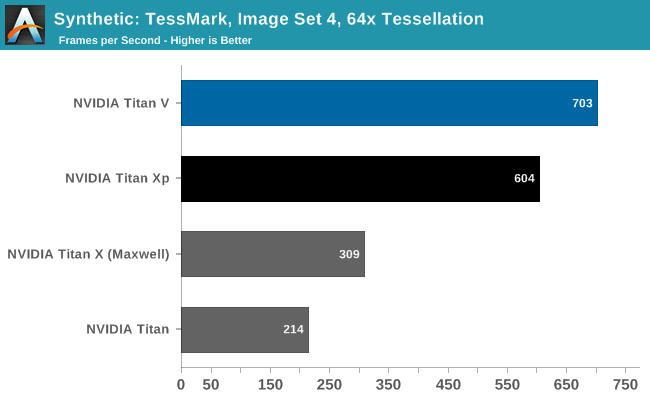
Right now the graphics aspects of the Volta architecture are something of a black box, and tessellation performance with TessMark reflects this. On Pascal, NVIDIA has one Polymorph engine per TPC; if this is the same on GV100, then Titan V has around 40% more geometry hardware than Titan Xp. On the other hand, the actual throughput rate of Polymorph engines has varied over the years as NVIDIA has dialed it up or down in line with their performance goals and the number of such hardware units available. So for all we know, Titan V’s Polymorph engines don’t pack the same punch as Titan Xp’s.
At any rate, Titan V once again comes away with a win. But the 16% lead is not a day-and-night difference, unlike what we’ve seen with compute.
Beyond3D Suite
Meanwhile for looking at texel and pixel fillrate, we have the Beyond3D Test Suite.
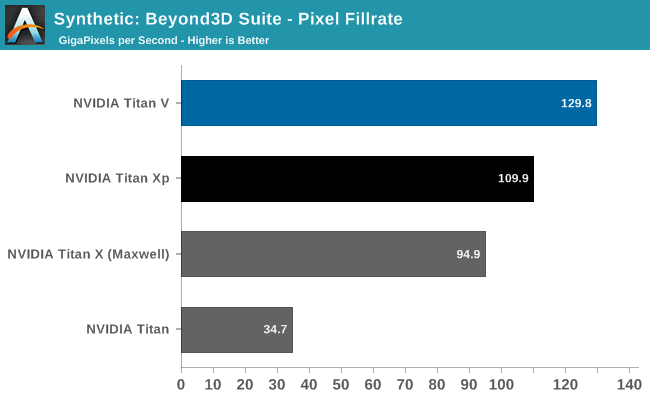
Starting with the pixel throughput benchmark, I’m actually a bit surprised the difference is as great as it is. As discussed earlier, on paper the Titan V has lower ROP throughput than the Titan Xp, owing to lower clockspeeds. And yet in this case it’s still in the lead by 18%. It’s not a massive difference, but it means the picture is more complex than naïve interpretation of GV100 being a bigger Pascal. This may be an under-the-hood efficiency improvement (such as compression), or it could just be due to Titan V’s raw bandwidth advantage. This will be worth keeping an eye on once NVIDIA starts talking about consumer Volta cards.
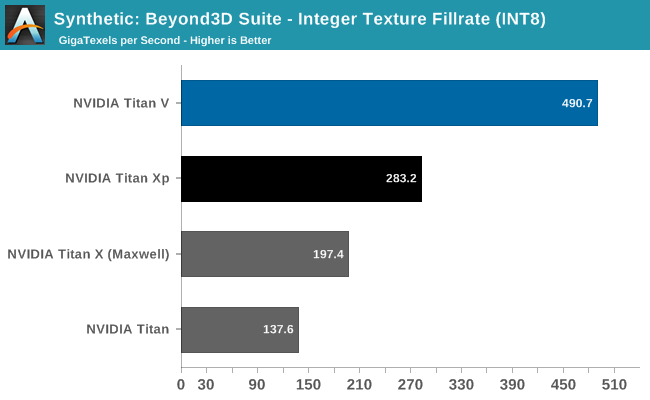
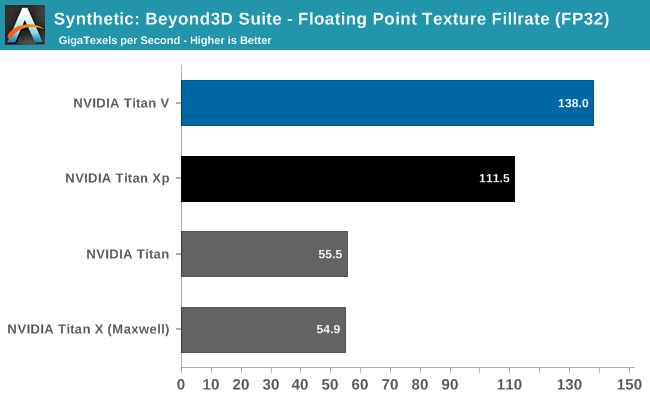
As for texel throughput, it’s interesting that INT8 and FP32 texture throughput gains are so divergent. Titan V is showing much greater INT8 texture throughput gains than it is FP32; and Titan Xp was no slouch in that department to begin with. I’m curious whether this is a product of separating the integer ALUs from the FP ALUs on Volta, or whether NVIDIA has made some significant changes to their texture mapping units.
3DMark Fire Strike Ultra
I’ve also gone ahead and run Futuremark’s 3DMark Fire Strike Ultra benchmark on the Titans. This benchmark is a bit older, but it’s a better understood (and better optimized) DX11 benchmark.
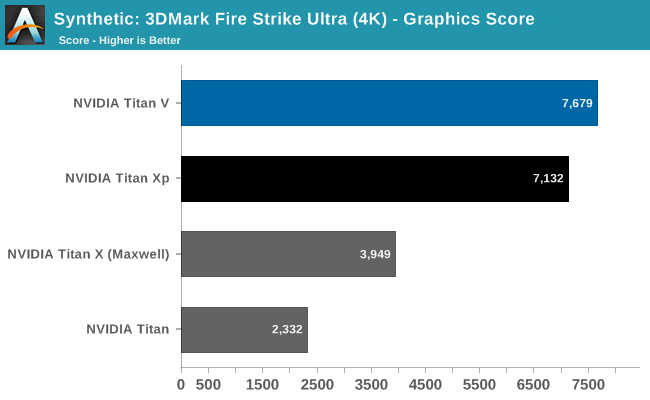
The results here find the Titan V in the lead, but not by much: just 8%. Relative to Pascal/Titan Xp, Titan V’s performance advantages and architectural improvements are inconsistent, in as much as not everything has been improved to the same degree. These results point to a bottleneck elsewhere – perhaps the ROPs? – but don’t isolate it. More significantly though, it’s an indication that while Titan V can do graphics, perhaps it’s not well-built (or at least well-optimized) for the task.
SPECViewPerf 12.1.1
Finally, while SPECViewPerf’s component software packages are more for the professional visualization side of the market – and NVIDIA doesn’t optimize the GeForce driver stack for these programs – I wanted to quickly run all of the Titans through the test all the same, just to see what we’d get.
| NVIDIA Titan Cards SPECviewperf 12.1 FPS Scores | ||||||
| Titan V | Titan Xp | GTX Titan X | GTX Titan | |||
| 3dsmax-05 | 176.3 | 173.7 | 133.1 | 100.3 | ||
| catia-04 | 180.3 | 181.4 | 71.3 | 24.1 | ||
| creo-01 | 119.4 | 122.1 | 41.0 | 30.1 | ||
| energy-01 | 27.7 | 21.2 | 8.7 | 5.8 | ||
| maya-04 | 159.0 | 152.0 | 131.6 | 98.6 | ||
| medical-01 | 89.4 | 91.9 | 39.9 | 27.7 | ||
| showcase-01 | 175.5 | 167.0 | 98.7 | 67.0 | ||
| snx-02 | 223.2 | 225.3 | 7.37 | 4.1 | ||
| sw-03 | 110.1 | 100.7 | 52.2 | 41.3 | ||
The end result is actually quite interesting. The Titan V only wins a bit more than it loses, as the card doesn’t pick up much in the way of performance versus the Titan Xp. Professional visualization tasks tend to be more ROP-bound, so this may be a consequence of that, and I wouldn’t read too much into this versus anything Quadro (or what a Quadro GV100 card could do). But it illustrates once again how Titan V has improved at some tasks by more than it has in others.










111 Comments
View All Comments
tipoo - Wednesday, December 20, 2017 - link
This would be a pretty bad choice for mining.The tensor cores don't work on any current mining algorithm. The CUDA cores have a small uplift. Two 1080s would be much faster miners.
lazarpandar - Wednesday, December 20, 2017 - link
Really disappointed that there isn’t a tensorflow performance tab since there is literally a physical portion of the gpu dedicated to tensor cores.Ryan Smith - Wednesday, December 20, 2017 - link
The good news is that we're working on that for the full review. The deep learning frameworks are a lot harder to test, and we were running out of time ahead of the holiday break, so it had to get pulled. It's definitely looking interesting though.SharpEars - Wednesday, December 20, 2017 - link
I applaud the increase in double-precision, but 12 GB of VRAM, seriously? For a $3k card?DanNeely - Wednesday, December 20, 2017 - link
Blame problems with either the memory controller and/or the interposer connecting the HBM2. NVidia kept the core count the same vs Tesla, but dropped one of the 4 ram stacks; so we know that something related to that was the biggest failure point in turning dies into even more expensive Tesla cards.Titan V refresh might get the 4th stack for 16GB in a year or so if yields improve enough to justify it; otherwise the question for more ram becomes if/when 8GB stacks of HBM2 are available in sufficient quantity.
extide - Saturday, December 23, 2017 - link
Vega FE and 16GB Mac Pro versions use the 8GB stacks, so they are available to some degree..mode_13h - Wednesday, December 27, 2017 - link
Nvidia's market segmentation tactics won't allow for 16 GB of HBM2 at such a bargain price. You might get it in the form of a Quadro GV100, however, for >= $2x of Titan V.beisat - Wednesday, December 20, 2017 - link
I fully expect the rumours to be true and Volta to be skipped for gaming by NV - already we heard of a replacement (Ampere) and this points that way too. Just a feeling though...Qwertilot - Wednesday, December 20, 2017 - link
Well, there’s no way they’d ever include a lot of the compute features in gaming cards so the two were always going to be pretty different.What they end up calling everything is a bit of a moot point :)
crysis3? - Wednesday, December 20, 2017 - link
so why'd you run the benchmark on the original crysis no one benchmarks? I assume the titan v cannot get 60fps maxed out on crysis 3 then.